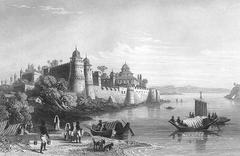Old Naini Bridge in Prayagraj: Visiting Hours, Tickets, and Historical Significance
Date: 18/07/2024
Introduction
Beyond its historical and architectural significance, the Old Naini Bridge continues to be a vital lifeline for Prayagraj, facilitating daily commutes and serving as a cultural hub during major events like the Kumbh Mela. This comprehensive guide delves into the bridge’s rich history, architectural features, cultural significance, and practical information for visitors, providing a deeper understanding of this iconic landmark.
Table of Contents
- [History and Construction of the Old Naini Bridge](#history-and-construction-of-the-old-naini-bridgehistory-and-construction-of-the-old-naini-bridge)
- [Early Plans and Construction](#early-plans-and-constructionearly-plans-and-construction)
- [The Bridge Takes Shape](#the-bridge-takes-shapethe-bridge-takes-shape)
- [Inauguration and Early Years](#inauguration-and-early-yearsinauguration-and-early-years)
- [Architectural Significance](#architectural-significancearchitectural-significance)
- [The Bridge’s Role in History](#the-bridges-role-in-historythe-bridges-role-in-history)
- [Visiting the Old Naini Bridge](#visiting-the-old-naini-bridgevisiting-the-old-naini-bridge)
- [Visitor Information](#visitor-informationvisitor-information)
- [Special Events and Guided Tours](#special-events-and-guided-toursspecial-events-and-guided-tours)
- [Legacy of the Old Naini Bridge](#legacy-of-the-old-naini-bridgelegacy-of-the-old-naini-bridge)
- [FAQs](#faqsfaqs)
- [Conclusion](#conclusionconclusion)
- [Call to Action](#call-to-actioncall-to-action)
History and Construction of the Old Naini Bridge
Early Plans and Construction
The need for a bridge connecting Allahabad to its suburb, Naini, became increasingly apparent in the late 19th century. The East Indian Railway Company, instrumental in developing India’s rail infrastructure, recognized the strategic importance of this connection.
The bridge’s construction, sanctioned in 1863, faced numerous challenges. The unpredictable nature of the Yamuna River, with its fluctuating water levels and shifting sandbanks, demanded innovative engineering solutions.
The Bridge Takes Shape
Renowned engineer Frederick Thomas Granville Walton, celebrated for his work on bridges across the world, including the iconic Britannia Bridge in Wales, was entrusted with the project. Walton’s design, featuring 16 spans supported by massive brick piers, addressed the river’s challenges.
Construction commenced in 1865, employing a workforce of thousands. The bridge’s piers, a marvel of engineering, were built using a unique pneumatic caisson method. This technique involved sinking large iron cylinders to the riverbed and then excavating the sand and silt from within, allowing the piers to be built upward.
Inauguration and Early Years
After five years of arduous labor, the Old Naini Bridge was formally inaugurated in 1870. This marked a significant milestone in Allahabad’s development, facilitating trade, transportation, and communication. The bridge quickly became a lifeline for the region, connecting people and goods across the Yamuna.
Architectural Significance
The Old Naini Bridge is an excellent example of 19th-century railway bridge architecture. Its design, characterized by sturdy brick piers, elegant arches, and a robust iron superstructure, reflects the functional yet aesthetically pleasing approach of the Victorian era. The bridge’s enduring strength, having withstood monsoons and the test of time, is a testament to the quality of its construction.
The Bridge’s Role in History
Beyond its functional purpose, the Old Naini Bridge has been a silent observer to India’s historical narrative. It witnessed the fervor of the Indian independence movement, with Allahabad playing a pivotal role. The bridge also served as a crucial link during the partition of India, witnessing the movement of countless people between India and Pakistan.
Visiting the Old Naini Bridge
Visitor Information
- Visiting Hours: The Old Naini Bridge is accessible to pedestrians and rail traffic at all times. However, it is advisable to visit during daylight hours for safety and better visibility.
- Tickets: There is no entry fee to visit the Old Naini Bridge.
- How to Get There: The bridge is located in Prayagraj, easily accessible by local transport such as auto-rickshaws, taxis, and buses.
- Nearby Attractions: While in Prayagraj, consider visiting other historical sites such as the Allahabad Fort, Anand Bhavan, and the Triveni Sangam.
- Travel Tips: Wear comfortable walking shoes and carry water, especially if visiting during the summer months.
- Accessibility: The bridge is accessible to pedestrians, but those with mobility issues may find it challenging due to the uneven surface.
Special Events and Guided Tours
Occasionally, local tour operators offer guided tours that include the Old Naini Bridge, providing deeper insights into its history and significance. Additionally, the bridge is a popular spot for photography, especially during sunrise and sunset.
Legacy of the Old Naini Bridge
The Old Naini Bridge is more than just a structure of iron and brick; it’s a symbol of Prayagraj’s resilience, ambition, and connection to its past. It stands as a reminder of the city’s evolution, the engineering ingenuity of a bygone era, and the enduring power of human endeavor. A visit to Prayagraj is incomplete without experiencing the grandeur and historical significance of the Old Naini Bridge.
FAQs
- What are the visiting hours for the Old Naini Bridge? The bridge is accessible to pedestrians and rail traffic at all times, but it’s best to visit during daylight hours.
- Are there any guided tours available for the Old Naini Bridge? Yes, some local tour operators offer guided tours that include the Old Naini Bridge.
- Is there an entry fee to visit the Old Naini Bridge? No, there is no entry fee.
- How do I get to the Old Naini Bridge? The bridge is located in Prayagraj and is easily accessible by local transport such as auto-rickshaws, taxis, and buses.

